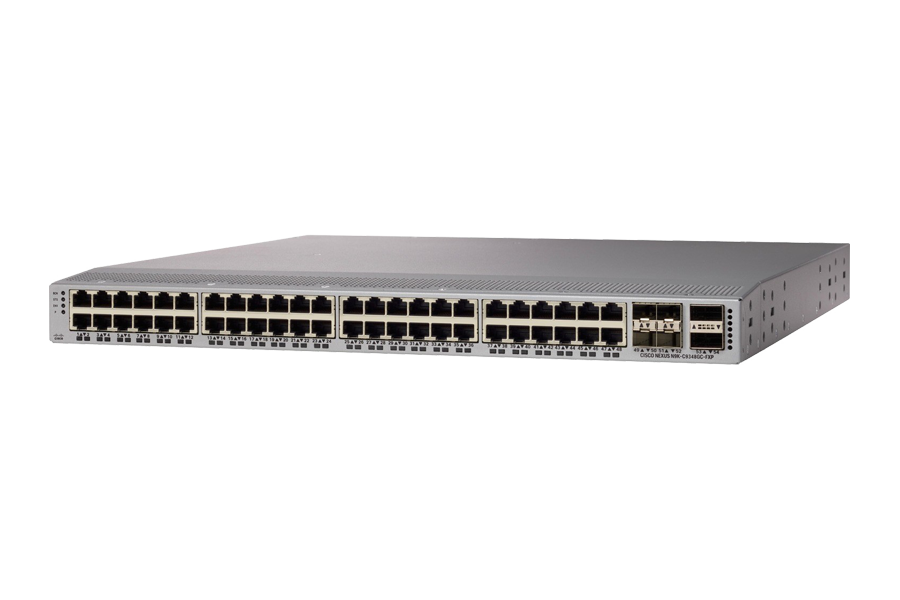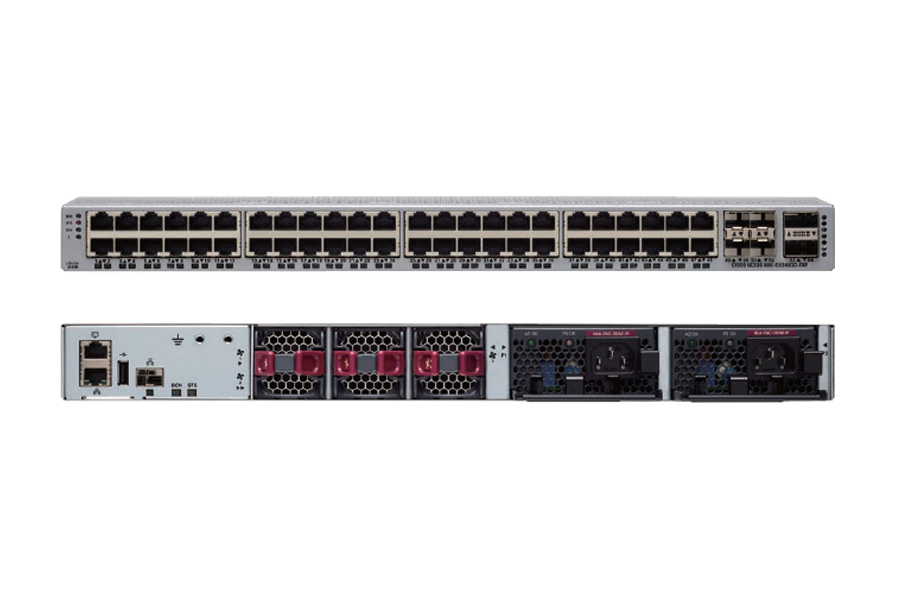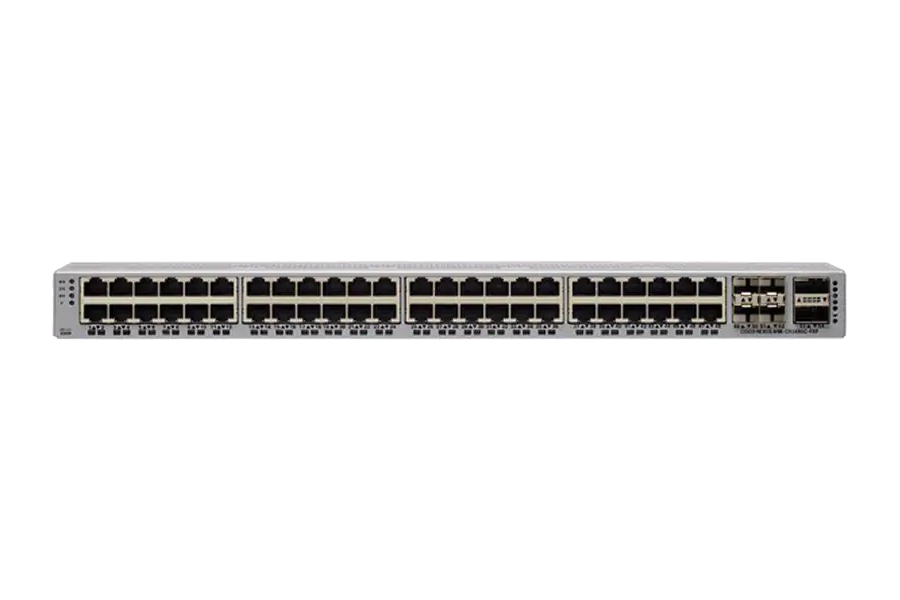


Cisco Systems 2 Nexus 9348GC-FXP with 4 N9K-C9348-FX-B14Q
2 Nexus 9348GC-FXP with 4 QSFP-40G-SR-BD
Description
Product overview
The Cisco Nexus® 9300-FX Series switches belongs to the fixed Cisco Nexus 9000 platform based on Cisco Cloud Scale technology. The platform support cost-effective cloud-scale deployments, an increased number of endpoints, and cloud services with wire-rate security and telemetry. The platform is built on modern system architecture designed to provide high performance and meet the evolving needs of highly scalable data centers and growing enterprises.
Cisco Nexus 9300-FX series switches offer a variety of interface options to transparently migrate existing data centers from 100-Mbps, 1-Gbps, and 10-Gbps speeds to 25- Gbps at the server, and from 10- and 40-Gbps speeds to 50- and 100- Gbps at the aggregation layer. The platforms provide investment protection for customers, delivering large buffers, highly flexible Layer 2 and Layer 3 scalability, and performance to meet the changing needs of virtualized data centers and automated cloud environments.
Cisco provides two modes of operation for Cisco Nexus 9000 Series Switches. Organizations can use Cisco NX-OS Software to deploy the switches in standard Cisco Nexus switch environments (NX-OS mode). Organizations can also deploy the infrastructure that is ready to support the Cisco Application Centric Infrastructure (Cisco ACI™) platform to take full advantage of an automated, policy-based, systems-management approach (ACI mode).
The Cisco Nexus 9348GC-FXP Switch (Figure 3) is a 1RU switch that supports 696 Gbps of bandwidth and over 517 mpps. The 48 1GBASE-T downlink ports on the 9348GC-FXP can be configured to work as 100-Mbps, 1-Gbps ports. The 4 ports of SFP28 can be configured as 1/10/25-Gbps and the 2 ports of QSFP28 can be configured as 40- and 100-Gbps ports, or a combination of 1-, 10-, 25-, 40, 50-, and 100-Gbps connectivity, offering flexible migration options.
The Cisco Nexus 9348GC-FXP is ideal for big data customers that require a Gigabit Ethernet ToR switch with local switching.
Features and benefits
The Cisco Nexus 9300-FX series provide the following features and benefits:
- Architectural Flexibility
- Industry leading Software Defined Networking Solution Cisco ACI™support.
- Support for standards based VXLAN EVPN fabrics, inclusive of hierarchical multi-site support (refer to VXLAN Network with MP-BGP EVPN Control Plane for more information).
- Three-tier BGP architectures, enabling horizontal, non-blocking IPv6 network fabrics at web-scale.
- Segment routing allows the network to forward Multiprotocol Label Switching (MPLS) packets and engineer traffic without Resource Reservation Protocol (RSVP) Traffic Engineering (TE). It provides a control-plane alternative for increased network scalability and virtualization.
- Comprehensive protocol support for Layer 3 (v4/v6) unicast and multicast routing protocol suites, including BGP, Open Shortest Path First (OSPF), Enhanced Interior Gateway Routing Protocol (EIGRP), Routing Information Protocol Version 2 (RIPv2), Protocol Independent Multicast Sparse Mode (PIM-SM), Source-Specific Multicast (SSM), and Multicast Source Discovery Protocol (MSDP).
- Extensive Programmability
- Day zero automation through Power On Auto Provisioning, drastically reducing provisioning time.
- Industry leading integrations for leading devops configuration management applications – Ansible, Chef, Puppet, SALT. Extensive Native YANG and industry standard OpenConfig model support through RESTCONF/NETCONF.
- Pervasive API’s for all switch CLI functions (JSON based RPC over HTTP/HTTPs).
- High Scalability, Flexibility, and Security
- Flexible forwarding tables support up to 2 million shared entries on FX models. Flexible use of TCAM space allows for custom definition of Access Control List (ACL) templates.
- IEEE 802.1ae MAC Security (MACsec) support on all ports of 9300-FX models with speed greater than or equal to 10-Gbps, allows traffic encryption at the physical layer and provides secure server, border leaf, and leaf-to-spine connectivity.
- Intelligent Buffer Management
- The platform offers Cisco’s innovative intelligent buffer management, that offers capability to distinguish mice and elephant flows and apply different queue management schemes to them based on their network forwarding requirements in the event of link congestion.
- Intelligent buffer management functions are:
- Approximate Fair Dropping (AFD) with Elephant trap (ETRAP). AFD distinguishes long-lived elephant flows from short-lived mice flows, by using ETRAP. AFD exempts mice flows from the dropping algorithm so that mice flows will get their fair share of bandwidth without being starved by bandwidth-hungry elephant flows. Also, AFD tracks elephant flows and subjects them to the AFD algorithm in the egress queue to grant them their fair share of bandwidth.
- ETRAP measures the byte counts of incoming flows and compares this against the user defined ETRAP threshold. After a flow crosses the threshold, it becomes an elephant flow.
- Dynamic Packet Prioritization (DPP) provides the capability of separating mice flows and elephant flows into two different queues so that buffer space can be allocated to them independently. Mice flows, sensitive to congestion and latency can take priority queue and avoid re-ordering that allows to elephant flows to take full link bandwidth.
- RDME over Converged Ethernet – RoCE Support
- Platform offers lossless transport for RDMA over Converged Ethernet with support of DCB protocols:
- Priority-based Flow Control – (PFC) to prevent drops in the network and pause frame propagation per priority class.
- Enhanced Transmission Selection – (ETS) to reserve bandwidth per priority class in network contention situation.
- Data Center Bridging Exchange Protocol – (DCBX) to discover and exchange priority and bandwidth information with end points.
- Platform also supports Explicit Congestion Notification – (ECN) that provides end-to-end notification per IP flow by marking packets that experienced congestion, without dropping traffic. The platform is capable to track ECN statistics of number of marked packet that have experienced congestion.
- LAN and SAN Convergence
- Fibre Channel[3] and Fibre Channel over Ethernet (FCoE) N-Port Virtualization (NPV) support enables the network administrator to control domain IDs and points of management on a Fibre Channel network as it scales. This feature enables LAN and SAN converged networks on a lossless, reliable Ethernet network.
- Hardware and Software High Availability
- Virtual Port-Channel (vPC) technology provides Layer 2 multipathing through the elimination of Spanning Tree Protocol. It also enables fully utilized bisectional bandwidth and simplified Layer 2 logical topologies without the need to change the existing management and deployment models.
- The 64-way Equal-Cost MultiPath (ECMP) routing enables the use of Layer 3 fat-tree designs. This feature helps organizations prevent network bottlenecks, increase resiliency, and add capacity with little network disruption.
- Advanced reboot capabilities include hot and cold patching.
- The switches use hot-swappable Power-Supply Units (PSUs) and fans with N+1 redundancy.
- Purpose-Built Cisco NX-OS Software Operating System with Comprehensive, Proven Innovations
- Single binary image that supports every switch in the Cisco Nexus 9000 series, simplifying image management. The operating system is modular, with a dedicated process for each routing protocol: a design that isolates faults while increasing availability. In the event of a process failure, the process can be restarted without loss of state. The operating system supports hot and cold patching and online diagnostics.
- Data Center Network Manager (DCNM) is the network management platform for all NX-OS-enabled deployments, spanning new fabric architectures, IP Fabric for Media, and storage networking deployments for the Cisco Nexus®-powered data center. Accelerate provisioning from days to minutes, and simplify deployments from day zero through day N. Reduce troubleshooting cycles with graphical operational visibility for topology, network fabric, and infrastructure. Eliminate configuration errors and automate ongoing change in a closed loop, with templated deployment models and configuration compliance alerting with automatic remediation. Real-time health summary for fabric, devices, and topology. Correlated visibility for fabric (underlay, overlay, virtual and physical endpoints), including compute visualization with VMware.
- Network traffic monitoring with Cisco Nexus Data Broker builds simple, scalable, and cost-effective network Test Access Points (TAPs) and Cisco Switched Port Analyzer (SPAN) aggregation for network traffic monitoring and analysis.
- Cisco Tetration Analytics Platform Support
- The telemetry information from the Nexus 9300 Series switches is exported every 100 milliseconds by default directly from the switch’s Application-Specific Integrated Circuit (ASIC). This information consists of three types of data: (a) Flow information, this information contains information about endpoints, protocols, ports, when the flow started, how long the flow was active, etc. (b) Inter-packet variation, this information captures any inter-packet variations within the flow. Examples include variation in Time To Live (TTL), IP and TCP flags, payload length, etc. (c) Context details, context information is derived outside the packet header, including variation in buffer utilization, packet drops within a flow, association with tunnel endpoints, etc.
- The Cisco Tetration Analytics platform consumes this telemetry data, and by using unsupervised machine learning and behavior analysis it can provide outstanding pervasive visibility across everything in your data center in real time. By using algorithmic approaches, the Cisco Tetration Analytics platform provides a deep application insights and interactions, enabling dramatically simplified operations, a zero-trust model, and migration of applications to any programmable infrastructure. To learn more, go to https://www.cisco.com/go/tetration.
- Cisco Network Assurance Engine (NAE)
- Cisco NAE continuously verifies if the network infrastructure is operating as per policy intent and it leverages the power of mathematical models to reason on behalf of the operator in policy, configuration and dynamic state level. NAE can precisely indicate problems in the network, identify which application or part of network is impacted, root-cause the problem and suggest how to fix it. Its continuous verification approach transforms Day 2 Operations from reactive to proactive mode and it does so without using any packet data. NAE helps avoid outages by predicting the impact of changes, reducing network related IT incidents and shrinking the mean time to repair by up to 66%. NAE also helps assure network security and segmentation compliance. To learn more about NAE, visit https://www.cisco.com/c/en/us/products/data-center-analytics/network-assurance-engine/index.html.
Specifications
- Description : 48 x 100M/1G BASE-T ports, 4 x 1/10/25-Gbps SFP28 ports and 2 x 40/100-Gbps QSFP28 ports
- Ports : 48 x 1-GBASE-T ports, 4 x 1/10/25-Gbps SFP28 ports and 2 x 40/100 QSFP28 ports
- Downlink supported speeds : 100-Mbps and 1-Gbps speeds
- CPU : 4 cores
- System memory : 24 GB
- SSD drive : 128 GB
- System buffer : 40 MB
- Management ports : 2 ports: 1 RJ-45 and 1 SFP+
- USB ports : 1
- RS-232 serial ports : 1
- Power supplies (up to 2) : 350W AC, 440W DC
- Typical power (AC/DC)* : 178W
- Maximum power (AC/DC)* : 287W
- Input voltage (AC) : 100 to 240V
- Input voltage (High-Voltage AC [HVAC]) : 90 to 305V
- Input voltage (DC) : -36V to -72V
- Input voltage (High-Voltage DC [HVDC]) : 192 to 400V
- Frequency (AC) : 50 to 60 Hz
- Fans : 3
- Airflow : Port-side intake and exhaust
- Physical dimensions (H x W x D) :
- 1.72 x 17.3 x 19.7 in.
- (4.4 x 43.9 x 49.9 cm)
- Acoustics : 67.5 dBA at 50% fan speed, 73.2 dBA at 70% fan speed, and 81.6 dBA at 100% fan speed
- RoHS compliance : Yes
- MTBF : 257,860 hours
- Minimum ACI image : ACI-N9KDK9-13.0
- Minimum NX-OS image : NXOS-703I7.1
Hardware performance and scalability specifications*
- Maximum number of Longest Prefix Match (LPM) routes** : 1,792,000
- Maximum number of IP host entries** : 1,792,000
- Maximum number of MAC address entries** : 512,000
- Maximum number of multicast routes : 128,000
- Number of Interior Gateway Management Protocol (IGMP) snooping groups
- Shipping: 8,000
- Maximum: 32,000
- Maximum number of Cisco Nexus 2000 Series Fabric Extenders per switch : 16
- Maximum number of Access Control List (ACL) entries
- Single-slice forwarding engine:
- 5000 ingress
- 2000 egress
- Maximum number of VLANs : 4096**
- Number of Virtual Routing and Forwarding (VRF) instances
- Shipping: 1,000
- Maximum: 16,000
- Maximum number of ECMP paths : 64
- Maximum number of port channels : 512
- Maximum number of links in a port channel : 32
- Number of active SPAN sessions : 4
- Maximum number of VLAN’s in Rapid per-VLAN Spanning Tree (RPVST) instances : 3,967
- Maximum number of Hot-Standby Router Protocol (HSRP) groups : 490
- Number of Network Address Translation (NAT) entries : 1,023
- Maximum number of Multiple Spanning Tree (MST) instances : 64
- Flow-table size used for Cisco Tetration Analytics platform*** : 64,000
- Number of Queues : 8
Environmental properties
- Operating temperature : 32 to 104°F (0 to 40°C)
- Nonoperating (storage) temperature : –40 to 158°F (–40 to 70°C)
- Humidity : 5 to 95% (noncondensing)
- Altitude : 0 to 13,123 ft (0 to 4000m)
Weight
- Cisco Nexus 9348GC-FXP without power supplies or fans : 14.2 lb (6.44 kg)
- 350W AC power supply : 2.8 lb (1.27 kg)
- 440W DC power supply : 2.6 lb (1.27 kg)
- 500W AC power supply : 2.42 lb (1.1 kg)
- 930W DC power supply : 2.42 lb (1.1 kg)
- 1200W HVDC/HVAC power supply : 2.42 lb (1.1 kg)
- Fan tray: NXA-FAN-30CFM-F or NXA-FAN-30CFM-B : 0.26 lb (0.12 kg)
Regulatory Standards Compliance: Safety and EMC
- Regulatory compliance
- Products should comply with CE Markings according to directives 2004/108/EC and 2006/95/EC
- Safety
- NEBS
- UL 60950-1 Second Edition
- CAN/CSA-C22.2 No. 60950-1 Second Edition
- EN 60950-1 Second Edition
- IEC 60950-1 Second Edition
- AS/NZS 60950-1
- GB4943
- EMC: Emissions
- 47CFR Part 15 (CFR 47) Class A
- AS/NZS CISPR22 Class A
- CISPR22 Class A
- EN55022 Class A
- ICES003 Class A
- VCCI Class A
- EN61000-3-2
- EN61000-3-3
- KN22 Class A
- CNS13438 Class A
- EMC: Immunity
- EN55024
- CISPR24
- EN300386
- KN 61000-4 series
- RoHS : The product is RoHS-6 compliant with exceptions for leaded-ball grid-array (BGA) balls and lead press-fit connectors.
